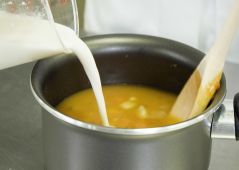Carbohydrates: caramelisation

How does it happen?
When simple sugars such as sucrose (or table sugar) are heated, they melt and break down into glucose and fructose, two other forms of sugar.
Continuing to heat the sugar at high temperature causes these sugars to lose water and react with each other producing many different types of compounds. These compounds are responsible for the different flavour elements of caramel for example butterscotch, nutty and toasty flavours. The increases in temperature causes the sugar to darken in colour.
This process also can occur during the heating of food with natural sugar, for example frying onions. As they are heated they turn from white to a golden brown colour. This is due to the natural sugars in the onions being caramelised.
Recap: caramelisation occurs when table sugar (sucrose) is heated at a high temperature.
BBC Bitesize: Everyday consumer products


